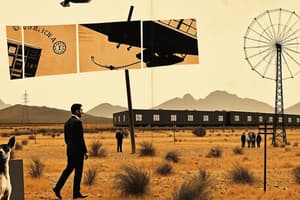Podcast
Questions and Answers
What internal conflict does Adam face in the narrative?
What internal conflict does Adam face in the narrative?
- A longing for revenge against his betrayals.
- The desire to assist versus feelings of helplessness. (correct)
- Anger towards societal injustice.
- The need for social acceptance in a changing world.
What significant transformation does Adam experience throughout the story?
What significant transformation does Adam experience throughout the story?
- He learns to forgive those who betrayed him.
- He becomes a leader in his community.
- He reconciles his past with his present.
- He faces his moral degradation through extreme decisions. (correct)
What common theme do Pauline Smith and C.M. van den Heever share in their perspectives?
What common theme do Pauline Smith and C.M. van den Heever share in their perspectives?
- A focus on urban development and modernization.
- An embrace of liberal individualism.
- A nostalgic view of rural life amid societal change. (correct)
- A commitment to progressive social reform.
How does Adam's relationship with characters like Canning and Baby contribute to the narrative?
How does Adam's relationship with characters like Canning and Baby contribute to the narrative?
What does Coetzee imply about the state of pastoral literature in the late 1920s?
What does Coetzee imply about the state of pastoral literature in the late 1920s?
What critique does Coetzee offer about the liberal-individualist tradition in South Africa?
What critique does Coetzee offer about the liberal-individualist tradition in South Africa?
Which aspect of past representations does van den Heever's perspective reflect?
Which aspect of past representations does van den Heever's perspective reflect?
What does Adam's eventual sacrifice of Blom signify in the narrative?
What does Adam's eventual sacrifice of Blom signify in the narrative?
What narrative technique does Galgut employ to create distance between Adam Napier and the reader?
What narrative technique does Galgut employ to create distance between Adam Napier and the reader?
Which of the following themes is NOT explicitly discussed in relation to Galgut's critique of post-apartheid South Africa?
Which of the following themes is NOT explicitly discussed in relation to Galgut's critique of post-apartheid South Africa?
How is Adam Napier's character primarily illustrated in relation to his background?
How is Adam Napier's character primarily illustrated in relation to his background?
What aspect of Adam Napier's worldview does Kostelac argue is anachronistic?
What aspect of Adam Napier's worldview does Kostelac argue is anachronistic?
In what way do landscapes and houses function in the narrative?
In what way do landscapes and houses function in the narrative?
What is a significant impact of colonial legacy as portrayed in Galgut's The Impostor?
What is a significant impact of colonial legacy as portrayed in Galgut's The Impostor?
What does Kostelac imply about Adam's romanticized view of the pastoral?
What does Kostelac imply about Adam's romanticized view of the pastoral?
Which of the following best describes the overall tone of Galgut's narrative as discussed by Kostelac?
Which of the following best describes the overall tone of Galgut's narrative as discussed by Kostelac?
What do the two competing dream topographies in South African pastoral literature represent?
What do the two competing dream topographies in South African pastoral literature represent?
How did writers like Schreiner view the concept of domestication of the African landscape?
How did writers like Schreiner view the concept of domestication of the African landscape?
What is the primary focus of Coetzee's analysis regarding language in relation to the African landscape?
What is the primary focus of Coetzee's analysis regarding language in relation to the African landscape?
What does the silence of the African landscape symbolize in Coetzee's discussion?
What does the silence of the African landscape symbolize in Coetzee's discussion?
What was the impact of diminishing ties with England on the South African literary landscape in the 1960s?
What was the impact of diminishing ties with England on the South African literary landscape in the 1960s?
Which theme is highlighted through the critique of pastoralism in South African literature?
Which theme is highlighted through the critique of pastoralism in South African literature?
In Coetzee's view, what do empty landscape artworks reflect about South African society?
In Coetzee's view, what do empty landscape artworks reflect about South African society?
What broader European ideas shaped perceptions of South Africa as discussed by Coetzee?
What broader European ideas shaped perceptions of South Africa as discussed by Coetzee?
Flashcards are hidden until you start studying
Study Notes
J.M. Coetzee on South African Pastoral Literature
- Coetzee examines the preservation of a rural order by South African pastoral writers in the late 1920s.
- Pauline Smith's idealism and fabricated notions of social stability contrast with C.M. van den Heever's organic mode of consciousness.
- Smith's vision of the farm "Harmonie" reflects a conservative European influence, mirroring English Tory traditions.
- Van den Heever's vision emphasizes a deep connection to the ancestral land, influenced by German Blut und Boden.
- Both Smith and van den Heever resisted the changing social and economic landscape of South Africa, showcasing the frailty of the liberal-individualist tradition.
- The Left's failure to unite white and black proletariats led to a persistent dream of a return to the family farm.
- Two competing dream topographies exist in South African pastoral literature: farms ruled by benevolent patriarchs and a vast, ancient Africa.
- Schreiner's depictions of Africa challenge the pastoral ideal of taming the landscape through agriculture.
- Coetzee focuses on the quest for a language that authentically captures Africa, beyond superficial understanding of indigenous languages.
- The ideal is to internalize these languages, requiring a profound transformation of identity.
- The poetry of the African landscape sought to establish a genuine dialogue with Africa, transcending visitor status.
- This strain of poetry waned in the 1960s as political and cultural ties with England weakened.
- The silence of the African landscape in response to the poet's call symbolizes the inability to imagine a cohesive South African society.
- The persistence of empty landscape art underscores the failure of the historical imagination.
- The landscape embodies the repressed histories and unresolved tensions within South African society.
- Pastoral art that seeks to humanize the landscape through labor and ideal communities often remains unattainable.
- Coetzee examines European ideas that shaped perceptions of South Africa, including notions of Man, progress, racial purity, and human-landscape harmony.
Analysis of The Impostor
- Landscapes, houses, and objects in the novel represent ideological inheritances from the apartheid past, which remain unacknowledged and untransformed.
- These objects are not external to subjectivity, but function as human, psychological, and affective contents.
- They are symptoms of historical amnesia and displaced whiteness.
- The reader is invited to understand subjectivity in architectural terms, capturing ethically charged interiors as political and human statements, reflecting a mode of living and thinking.
Dr Kostelac on Pastoral Mode
- Kostelac acknowledges that South Africa's socio-political reality undermines the hope for a new cosmopolitanism.
- Galgut's novel is a metafictional critique of the "petrified suspension" of white post-apartheid South Africa.
- Galgut uses the character of Adam Napier to showcase how pastoral and colonial scripts hinder a new cosmopolitanism.
- Adam's narrative of self-imposed exile and romanticized pastoralism exposes the anachronistic and self-serving nature of his worldview.
- Adam, disillusioned by post-apartheid changes, retreats to the Karoo to write poetry, enabled by his brother's ill-gotten wealth, highlighting his hypocrisy.
- Galgut's use of a third-person limited omniscient narrator creates ironic distance between Adam and the reader, exposing the contradictions in Adam's self-perception.
- Adam's pastoral idealism and self-righteousness are symptomatic of a broader, pervasive version of South African whiteness.
Studying That Suits You
Use AI to generate personalized quizzes and flashcards to suit your learning preferences.




